保護膜付き銀ミラー

- High Reflectance in Visible and NIR Regions
- Round, Square, and Rectangular Mirrors Available
PF40-03-P01
Ø4"
PF10-03-P01
Ø1"
PF30-03-P01
Ø3"
PF07-03-P01
Ø19 mm
PF03-03-P01
Ø7 mm
PFSQ05-03-P01
1/2" x 1/2"
PF05-03-P01
Ø1/2"
PFSQ10-03-P01
1" x 1"
PF20-03-P01
Ø2"
PFR10-P01
25 mm x 36 mm
PFR14-P02
35 mm x 52 mm
PF15-03-P01
Ø1.5"

Please Wait
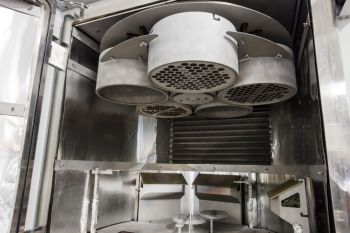
Click to Enlarge
電子ビーム蒸着コーティングチャンバ上部の円形基板ホルダに取り付けた金属ミラーブランク。
特長
- 可視ならびに近赤外域で高反射率の銀コーティング
- Ravg > 97%@450 nm~2 µm
- Ravg > 95%@2~20 µm
- SiO2保護膜により酸化を防止
- 円形、正方形、長方形ミラー、および10枚の円形ミラーセットをご用意
銀コーティングミラーは、可視~近赤外域において、当社の金属製コーティングの中で最も高い反射率を有します。また、赤外域においても高い反射率を有します(詳しくは下の表をご覧ください)。コーティングの反射率曲線は「グラフ」タブでご覧いただけます。また、酸化を防ぐため、これらのミラーには厚さ約100 nmの耐久性の高いSiO2保護膜が施されています。この保護膜は銀の変色を防ぎますが、高湿度環境でのご使用はお避けください。
450 nm~20 µmの範囲に渡り高い反射率を有するため、こちらのミラーはフェムト秒パルスレーザと組み合わせて使用するのに適しています。超短パルス用光学素子のラインナップについては「超短パルスレーザ用光学素子」のタブをご覧ください。
当社のØ19 mmミラーは、特にレーザーシステムや組み込み用途(OEM用途)に用いられるPolaris®固定式マウントに適合するように設計されています。Ø12.7 mm(Ø1/2インチ)光学素子よりも開口が大きいにもかかわらず、マウントの設置面積はØ25.4 mm(Ø1インチ)に収まります。また、35 mm x 52 mmミラーはDIY顕微鏡向けの2ポジションスライダ付き Cerna® ブレッドボードトップ用に特化しています。
Ø7 mmミラーならびに35 mm x 52 mmミラー以外の製品には、基板の裏に型番が刻印されており、識別しやすくなっています。Ø12.7 mm(Ø1/2インチ)、Ø25.4 mm(Ø1インチ)、Ø50.8 mm(Ø2インチ)円形銀ミラーについては単品価格よりお得な10個入りパックでもご提供しております。
取扱いについて
銀コーティング付きミラーは、環境や不適切な取り扱いによって損傷しやすいため、特にご注意いただく必要があります。指紋の付着、研磨性のある面との接触、高湿/高温の環境などにより、保護膜の効果が損なわれ、銀コーティングの酸化や劣化が起きやすくなります。 銀ミラーを取り扱う際は、通常の光学素子の取扱い方法に従ってください。 光学素子の表面に指の油分などが付着するのを防ぐために、Latex製手袋などの着用をお勧めします。こうした対策を講じたうえで、ミラー面やエッジには触れないようにご注意ください。 銀ミラーは、室温で、できるだけ湿度の低い場所で使用/保管を行ってください。ミラーなどの光学素子のクリーニング法については、「光学素子の取扱いについてのチュートリアル」をご参照ください。
カスタム仕様の金属製ミラー
当社の金属製ミラーはアメリカ、ニュージャージ州ニュートンの製造施設で製造されています。当社の光学素子事業部は幅広い製造能力を有しており、組み込み用途(OEM用途)や小ロット単発でのご相談もお受けしております。サイズ、形状、基板、ならびにコーティングをカスタマイズした光学素子やガルバノスキャナなどの特注部品をご提供可能です。カスタム品の詳細については当社までお問い合わせください。
| Metal-Coated Plano Mirrors Selection Guide | ||||
|---|---|---|---|---|
Wavelength Range | Avg. Reflectance | Coating | Suffix | Coating Comparison |
| 250 nm - 450 nm | > 90% | UV Enhanced Aluminum | -F01 | Raw Data |
| 450 nm - 20 μm | > 90% for 450 nm - 2 µm > 95% for 2 - 20 µm | Protected Aluminum | -G01 | |
| 750 nm - 1 µm | Rs > 99.0% RP > 98.5% | Ultrafast-Enhanced Silver | -AG | Raw Data |
| 450 nm - 20 μm | > 97% for 450 nm - 2 µm > 95% for 2 - 20 µm | Protected Silver | -P01 | |
| Protected Silver | -P02a | |||
| 800 nm - 20 μm | > 96% | Protected Gold | -M01 | Raw Data |
| 2 µm - 20 µm | > 98% | MIR Enhanced Gold | -M02 | |
| 800 nm - 20 μm | > 97% | Unprotected Gold | -M03 | |
| 10.6 µm Laser Line | > 99% | Unprotected Gold | -L01 | |
| Metal-Coated Zerodur® Mirrors | ||||
| Economy Front Surface Mirrors with Protected Metallic Coatings | ||||
グラフの網掛けの部分は、この光学素子をご使用になる際に推奨する波長範囲を示しています。この帯域外(特に反射率が変動したり傾斜したりしている範囲)の反射率は品質管理の面で厳密にモニタされておりません。また、ロットによってバラツキがある可能性がありますのでご注意ください。
| Damage Threshold Specifications | |
|---|---|
| Coating Designation (Item # Suffix) | Damage Threshold |
| -P01 (Pulsed) | 0.225 J/cm2 (800 nm, 99 fs, 1 kHz, Ø0.167 mm) 1 J/cm2 (1064 nm, 10 ns, 10 Hz, Ø1.010 mm) |
| -P01 (CWa) | 500 W/cm (1.07 µm, Ø0.974 mm) 1500 W/cm (10.6 µm, Ø0.339 mm) |
当社の-P01コーティング付き保護膜付き銀ミラーの損傷閾値データ
右の仕様は当社の-P01コーティング付き保護膜付き銀ミラーの測定値です。損傷閾値の仕様はコーティングの種類が同じであればミラーのサイズや形状にかかわらずすべての保護膜付き銀ミラーで同じです。
レーザによる損傷閾値について
このチュートリアルでは、レーザ損傷閾値がどのように測定され、使用する用途に適切な光学素子の決定にその値をどのようにご利用いただけるかを総括しています。お客様のアプリケーションにおいて、光学素子を選択する際、光学素子のレーザによる損傷閾値(Laser Induced Damage Threshold :LIDT)を知ることが重要です。光学素子のLIDTはお客様が使用するレーザの種類に大きく依存します。連続(CW)レーザは、通常、吸収(コーティングまたは基板における)によって発生する熱によって損傷を引き起こします。一方、パルスレーザは熱的損傷が起こる前に、光学素子の格子構造から電子が引き剥がされることによって損傷を受けます。ここで示すガイドラインは、室温で新品の光学素子を前提としています(つまり、スクラッチ&ディグ仕様内、表面の汚染がないなど)。光学素子の表面に塵などの粒子が付くと、低い閾値で損傷を受ける可能性があります。そのため、光学素子の表面をきれいで埃のない状態に保つことをお勧めします。光学素子のクリーニングについては「光学素子クリーニングチュートリアル」をご参照ください。
テスト方法
当社のLIDTテストは、ISO/DIS 11254およびISO 21254に準拠しています。
初めに、低パワー/エネルギのビームを光学素子に入射します。その光学素子の10ヶ所に1回ずつ、設定した時間(CW)またはパルス数(決められたprf)、レーザを照射します。レーザを照射した後、倍率約100倍の顕微鏡を用いた検査で確認し、すべての確認できる損傷を調べます。特定のパワー/エネルギで損傷のあった場所の数を記録します。次に、そのパワー/エネルギを増やすか減らすかして、光学素子にさらに10ヶ所レーザを照射します。このプロセスを損傷が観測されるまで繰返します。損傷閾値は、光学素子が損傷に耐える、損傷が起こらない最大のパワー/エネルギになります。1つのミラーBB1-E02の試験結果は以下のようなヒストグラムになります。
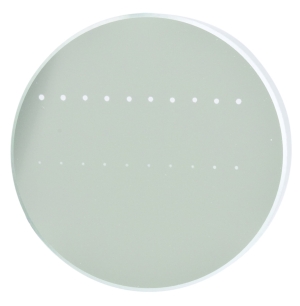
上の写真はアルミニウムをコーティングしたミラーでLIDTテストを終えたものです。このテストは、損傷を受ける前のレーザのエネルギは0.43 J/cm2 (1064 nm、10 ns pulse、 10 Hz、Ø1.000 mm)でした。
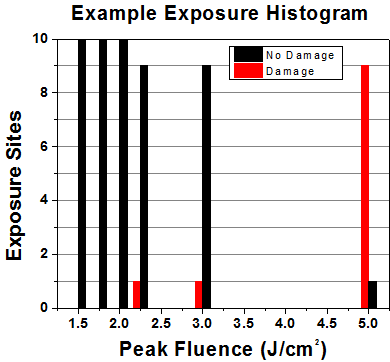
| Example Test Data | |||
|---|---|---|---|
| Fluence | # of Tested Locations | Locations with Damage | Locations Without Damage |
| 1.50 J/cm2 | 10 | 0 | 10 |
| 1.75 J/cm2 | 10 | 0 | 10 |
| 2.00 J/cm2 | 10 | 0 | 10 |
| 2.25 J/cm2 | 10 | 1 | 9 |
| 3.00 J/cm2 | 10 | 1 | 9 |
| 5.00 J/cm2 | 10 | 9 | 1 |
試験結果によれば、ミラーの損傷閾値は 2.00 J/cm2 (532 nm、10 ns pulse、10 Hz、 Ø0.803 mm)でした。尚、汚れや汚染によって光学素子の損傷閾値は大幅に低減されるため、こちらの試験はクリーンな光学素子で行っています。また、特定のロットのコーティングに対してのみ試験を行った結果ではありますが、当社の損傷閾値の仕様は様々な因子を考慮して、実測した値よりも低めに設定されており、全てのコーティングロットに対して適用されています。
CWレーザと長パルスレーザ
光学素子がCWレーザによって損傷を受けるのは、通常バルク材料がレーザのエネルギを吸収することによって引き起こされる溶解、あるいはAR(反射防止)コーティングのダメージによるものです[1]。1 µsを超える長いパルスレーザについてLIDTを論じる時は、CWレーザと同様に扱うことができます。
パルス長が1 nsと1 µs の間のときは、損傷は吸収、もしくは絶縁破壊のどちらかで発生していると考えることができます(CWとパルスのLIDT両方を調べなければなりません)。吸収は光学素子の固有特性によるものか、表面の不均一性によるものかのどちらかによって起こります。従って、LIDTは製造元の仕様以上の表面の質を有する光学素子にのみ有効です。多くの光学素子は、ハイパワーCWレーザで扱うことができる一方、アクロマティック複レンズのような接合レンズやNDフィルタのような高吸収光学素子は低いCWレーザ損傷閾値になる傾向にあります。このような低い損傷閾値は接着剤や金属コーティングにおける吸収や散乱によるものです。
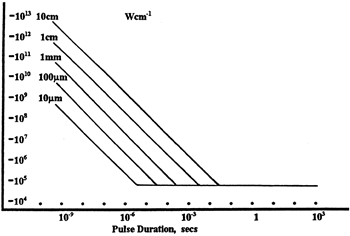
線形パワー密度におけるLIDTに対するパルス長とスポットサイズ。長パルス~CWでは線形パワー密度はスポットサイズにかかわらず一定です。 このグラフの出典は[1]です。
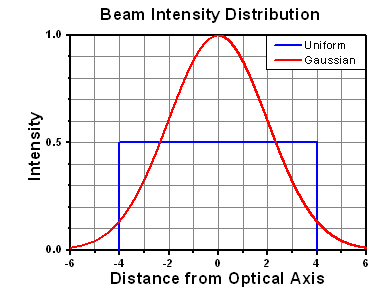
繰返し周波数(prf)の高いパルスレーザは、光学素子に熱的損傷も引き起こします。この場合は吸収や熱拡散率のような因子が深く関係しており、残念ながらprfの高いレーザが熱的影響によって光学素子に損傷を引き起こす場合の信頼性のあるLIDTを求める方法は確立されておりません。prfの大きいビームでは、平均出力およびピークパワーの両方を等しいCW出力と比較する必要があります。また、非常に透過率の高い材料では、prfが上昇してもLIDTの減少は皆無かそれに近くなります。
ある光学素子の固有のCWレーザの損傷閾値を使う場合には、以下のことを知る必要があります。
- レーザの波長
- ビーム径(1/e2)
- ビームのおおよその強度プロファイル(ガウシアン型など)
- レーザのパワー密度(トータルパワーをビームの強度が1/e2の範囲の面積で割ったもの)
ビームのパワー密度はW/cmの単位で計算します。この条件下では、出力密度はスポットサイズとは無関係になります。つまり、スポットサイズの変化に合わせてLIDTを計算し直す必要がありません(右グラフ参照)。平均線形パワー密度は、下の計算式で算出できます。

ここでは、ビーム強度プロファイルは一定であると仮定しています。次に、ビームがホットスポット、または他の不均一な強度プロファイルの場合を考慮して、おおよその最大パワー密度を計算する必要があります。ご参考までに、ガウシアンビームのときはビームの強度が1/e2の2倍のパワー密度を有します(右下図参照)。
次に、光学素子のLIDTの仕様の最大パワー密度を比較しましょう。損傷閾値の測定波長が光学素子に使用する波長と異なっている場合には、その損傷閾値は適宜補正が必要です。おおよその目安として参考にできるのは、損傷閾値は波長に対して比例関係であるということです。短い波長で使う場合、損傷閾値は低下します(つまり、1310 nmで10 W/cmのLIDTならば、655 nmでは5 W/cmと見積もります)。

この目安は一般的な傾向ですが、LIDTと波長の関係を定量的に示すものではありません。例えば、CW用途では、損傷はコーティングや基板の吸収によってより大きく変化し、必ずしも一般的な傾向通りとはなりません。上記の傾向はLIDT値の目安として参考にしていただけますが、LIDTの仕様波長と異なる場合には当社までお問い合わせください。パワー密度が光学素子の補正済みLIDTよりも小さい場合、この光学素子は目的の用途にご使用いただけます。
当社のウェブ上の損傷閾値の仕様と我々が行った実際の実験の値の間にはある程度の差があります。これはロット間の違いによって発生する誤差を許容するためです。ご要求に応じて、当社は個別の情報やテスト結果の証明書を発行することもできます。損傷解析は、類似した光学素子を用いて行います(お客様の光学素子には損傷は与えません)。試験の費用や所要時間などの詳細は、当社までお問い合わせください。
パルスレーザ
先に述べたように、通常、パルスレーザはCWレーザとは異なるタイプの損傷を光学素子に引き起こします。パルスレーザは損傷を与えるほど光学素子を加熱しませんが、光学素子から電子をひきはがします。残念ながら、お客様のレーザに対して光学素子のLIDTの仕様を照らし合わせることは非常に困難です。パルスレーザのパルス幅に起因する光学素子の損傷には、複数の形態があります。以下の表中のハイライトされた列は当社の仕様のLIDT値が当てはまるパルス幅に対する概要です。
パルス幅が10-9 sより短いパルスについては、当社の仕様のLIDT値と比較することは困難です。この超短パルスでは、多光子アバランシェ電離などのさまざまなメカニクスが損傷機構の主流になります[2]。対照的に、パルス幅が10-7 sと10-4 sの間のパルスは絶縁破壊、または熱的影響により光学素子の損傷を引き起こすと考えられます。これは、光学素子がお客様の用途に適しているかどうかを決定するために、レーザービームに対してCWとパルス両方による損傷閾値を参照しなくてはならないということです。
| Pulse Duration | t < 10-9 s | 10-9 < t < 10-7 s | 10-7 < t < 10-4 s | t > 10-4 s |
|---|---|---|---|---|
| Damage Mechanism | Avalanche Ionization | Dielectric Breakdown | Dielectric Breakdown or Thermal | Thermal |
| Relevant Damage Specification | No Comparison (See Above) | Pulsed | Pulsed and CW | CW |
お客様のパルスレーザに対してLIDTを比較する際は、以下のことを確認いただくことが重要です。
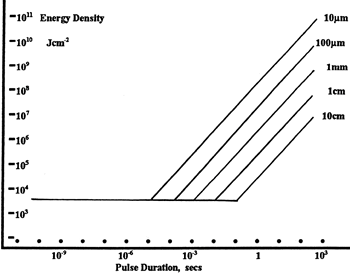
エネルギ密度におけるLIDTに対するパルス長&スポットサイズ。短パルスでは、エネルギ密度はスポットサイズにかかわらず一定です。このグラフの出典は[1]です。
- レーザの波長
- ビームのエネルギ密度(トータルエネルギをビームの強度が1/e2の範囲の面積で割ったもの)
- レーザのパルス幅
- パルスの繰返周波数(prf)
- 実際に使用するビーム径(1/e2 )
- ビームのおおよその強度プロファイル(ガウシアン型など)
ビームのエネルギ密度はJ/cm2の単位で計算します。右のグラフは、短パルス光源には、エネルギ密度が適した測定量であることを示しています。この条件下では、エネルギ密度はスポットサイズとは無関係になります。つまり、スポットサイズの変化に合わせてLIDTを計算し直す必要がありません。ここでは、ビーム強度プロファイルは一定であると仮定しています。ここで、ビームがホットスポット、または他の不均一な強度プロファイルの場合を考慮して、おおよその最大パワー密度を計算する必要があります。ご参考までに、ガウシアンビームのときは一般にビームの強度が1/e2のときの2倍のパワー密度を有します。
次に、光学素子のLIDTの仕様と最大エネルギ密度を比較しましょう。損傷閾値の測定波長が光学素子に使用する波長と異なっている場合には、その損傷閾値は適宜補正が必要です[3]。経験則から、損傷閾値は波長に対して以下のような平方根の関係であるということです。短い波長で使う場合、損傷閾値は低下します(例えば、1064 nmで 1 J/cm2のLIDTならば、532 nmでは0.7 J/cm2と計算されます)。

波長を補正したエネルギ密度を得ました。これを以下のステップで使用します。
ビーム径は損傷閾値を比較する時にも重要です。LIDTがJ/cm2の単位で表される場合、スポットサイズとは無関係になりますが、ビームサイズが大きい場合、LIDTの不一致を引き起こす原因でもある不具合が、より明らかになる傾向があります[4]。ここで示されているデータでは、LIDTの測定には<1 mmのビーム径が用いられています。ビーム径が5 mmよりも大きい場合、前述のようにビームのサイズが大きいほど不具合の影響が大きくなるため、LIDT (J/cm2)はビーム径とは無関係にはなりません。
次に、パルス幅について補正します。パルス幅が長くなるほど、より大きなエネルギに光学素子は耐えることができます。パルス幅が1~100 nsの場合の近似式は以下のようになります。

お客様のレーザのパルス幅をもとに、光学素子の補正されたLIDTを計算するのにこの計算式を使います。お客様の最大エネルギ密度が、この補正したエネルギ密度よりも小さい場合、その光学素子はお客様の用途でご使用いただけます。ご注意いただきたい点は、10-9 s と10-7 sの間のパルスにのみこの計算が使えることです。パルス幅が10-7 sと10-4 sの間の場合には、CWのLIDTも調べなければなりません。
当社のウェブ上の損傷閾値の仕様と我々が行った実際の実験の値の間にはある程度の差があります。これはロット間の違いによって発生する誤差を許容するためです。ご要求に応じて、当社では個別のテスト情報やテスト結果の証明書を発行することも可能です。詳細は、当社までお問い合わせください。
[1] R. M. Wood, Optics and Laser Tech. 29, 517 (1997).
[2] Roger M. Wood, Laser-Induced Damage of Optical Materials (Institute of Physics Publishing, Philadelphia, PA, 2003).
[3] C. W. Carr et al., Phys. Rev. Lett. 91, 127402 (2003).
[4] N. Bloembergen, Appl. Opt. 12, 661 (1973).
レーザーシステムが光学素子に損傷を引き起こすかどうか判断するプロセスを説明するために、レーザによって引き起こされる損傷閾値(LIDT)の計算例をいくつかご紹介します。同様の計算を実行したい場合には、右のボタンをクリックしてください。計算ができるスプレッドシートをダウンロードいただけます。ご使用の際には光学素子のLIDTの値と、レーザーシステムの関連パラメータを緑の枠内に入力してください。スプレッドシートでCWならびにパルスの線形パワー密度、ならびにパルスのエネルギ密度を計算できます。これらの値はスケーリング則に基づいて、光学素子のLIDTの調整スケール値を計算するのに用いられます。計算式はガウシアンビームのプロファイルを想定しているため、ほかのビーム形状(均一ビームなど)には補正係数を導入する必要があります。 LIDTのスケーリング則は経験則に基づいていますので、確度は保証されません。なお、光学素子やコーティングに吸収があると、スペクトル領域によってLIDTが著しく低くなる場合があります。LIDTはパルス幅が1ナノ秒(ns)未満の超短パルスには有効ではありません。

ガウシアンビームの最大強度は均一ビームの約2倍です。
CWレーザの例
波長1319 nm、ビーム径(1/e2)10 mm、パワー0.5 Wのガウシアンビームを生成するCWレーザーシステム想定します。このビームの平均線形パワー密度は、全パワーをビーム径で単純に割ると0.5 W/cmとなります。

しかし、ガウシアンビームの最大パワー密度は均一ビームの約2倍です(右のグラフ参照)。従って、システムのより正確な最大線形パワー密度は1 W/cmとなります。
アクロマティック複レンズAC127-030-CのCW LIDTは、1550 nmでテストされて350 W/cmとされています。CWの損傷閾値は通常レーザ光源の波長に直接スケーリングするため、LIDTの調整値は以下のように求められます。

LIDTの調整値は350 W/cm x (1319 nm / 1550 nm) = 298 W/cmと得られ、計算したレーザーシステムのパワー密度よりも大幅に高いため、この複レンズをこの用途に使用しても安全です。
ナノ秒パルスレーザの例:パルス幅が異なる場合のスケーリング
出力が繰返し周波数10 Hz、波長355 nm、エネルギ1 J、パルス幅2 ns、ビーム径(1/e2)1.9 cmのガウシアンビームであるNd:YAGパルスレーザーシステムを想定します。各パルスの平均エネルギ密度は、パルスエネルギをビームの断面積で割って求めます。

上で説明したように、ガウシアンビームの最大エネルギ密度は平均エネルギ密度の約2倍です。よって、このビームの最大エネルギ密度は約0.7 J/cm2です。
このビームのエネルギ密度を、広帯域誘電体ミラーBB1-E01のLIDT 1 J/cm2、そしてNd:YAGレーザーラインミラーNB1-K08のLIDT 3.5 J/cm2と比較します。LIDTの値は両方とも、波長355 nm、パルス幅10 ns、繰返し周波数10 Hzのレーザで計測しました。従って、より短いパルス幅に対する調整を行う必要があります。 1つ前のタブで説明したようにナノ秒パルスシステムのLIDTは、パルス幅の平方根にスケーリングします:

この調整係数により広帯域誘電体ミラーBB1-E01のLIDTは0.45 J/cm2に、Nd:YAGレーザーラインミラーのLIDTは1.6 J/cm2になり、これらをビームの最大エネルギ密度0.7 J/cm2と比較します。広帯域ミラーはレーザによって損傷を受ける可能性があり、より特化されたレーザーラインミラーがこのシステムには適していることが分かります。
ナノ秒パルスレーザの例:波長が異なる場合のスケーリング
波長1064 nm、繰返し周波数2.5 Hz、パルスエネルギ100 mJ、パルス幅10 ns、ビーム径(1/e2)16 mmのレーザ光を、NDフィルタで減衰させるようなパルスレーザーシステムを想定します。これらの数値からガウシアン出力における最大エネルギ密度は0.1 J/cm2になります。Ø25 mm、OD 1.0の反射型NDフィルタ NDUV10Aの損傷閾値は355 nm、10 nsのパルスにおいて0.05 J/cm2で、同様の吸収型フィルタ NE10Aの損傷閾値は532 nm、10 nsのパルスにおいて10 J/cm2です。1つ前のタブで説明したように光学素子のLIDTは、ナノ秒パルス領域では波長の平方根にスケーリングします。

スケーリングによりLIDTの調整値は反射型フィルタでは0.08 J/cm2、吸収型フィルタでは14 J/cm2となります。このケースでは吸収型フィルタが光学損傷を防ぐには適した選択肢となります。
マイクロ秒パルスレーザの例
パルス幅1 µs、パルスエネルギ150 µJ、繰返し周波数50 kHzで、結果的にデューティーサイクルが5%になるレーザーシステムについて考えてみます。このシステムはCWとパルスレーザの間の領域にあり、どちらのメカニズムでも光学素子に損傷を招く可能性があります。レーザーシステムの安全な動作のためにはCWとパルス両方のLIDTをレーザーシステムの特性と比較する必要があります。
この比較的長いパルス幅のレーザが、波長980 nm、ビーム径(1/e2)12.7 mmのガウシアンビームであった場合、線形パワー密度は5.9 W/cm、1パルスのエネルギ密度は1.2 x 10-4 J/cm2となります。これをポリマーゼロオーダ1/4波長板WPQ10E-980のLIDTと比較してみます。CW放射に対するLIDTは810 nmで5 W/cm、10 nsパルスのLIDTは810 nmで5 J/cm2です。前述同様、光学素子のCW LIDTはレーザ波長と線形にスケーリングするので、CWの調整値は980 nmで6 W/cmとなります。一方でパルスのLIDTはレーザ波長の平方根とパルス幅の平方根にスケーリングしますので、1 µsパルスの980 nmでの調整値は55 J/cm2です。光学素子のパルスのLIDTはパルスレーザのエネルギ密度よりはるかに大きいので、個々のパルスが波長板を損傷することはありません。しかしレーザの平均線形パワー密度が大きいため、高出力CWビームのように光学素子に熱的損傷を引き起こす可能性があります。
| Posted Comments: | |
user
(posted 2024-03-18 18:01:31.973) Hello, can you provide us with phase shift of p- and s-polarized light? We want information about silver ('-P01') and aluminium ('-F01') mirrors. jdelia
(posted 2024-03-19 08:29:26.0) Thank you for contacting Thorlabs. I have contacted you directly to provide you with the requested data. Alberto Martin-Ortega
(posted 2024-03-14 10:28:11.03) We are looking for a product similar to PF40-03-P01, but with a diameter of 200 to 300 mm. Is it possible? ksosnowski
(posted 2024-03-14 12:08:54.0) Hello Alberto, thanks for reaching out to Thorlabs. I have contacted you directly to discuss this potential custom sized mirror. user
(posted 2023-06-19 14:42:50.97) Dear Team
I would really like to know the significance of this 0.225 J/cm2 (800 nm, 99 fs, 1 kHz, Ø0.167 mm) for the damage threshold. Can we take this number as a reference for calculating the damage threshold for a femtosecond laser? cdolbashian
(posted 2023-06-23 11:14:43.0) Thank you for reaching out to us with this inquiry. Unless these pulse parameters exactly match your laser, this number should only be taken as a guideline, as the scaling of ultrashort pulse lasers is not as convenient as for slower pulse lasers or CW lasers. I have contacted you directly to discuss this. user
(posted 2023-04-19 20:58:48.71) What effect do dielectric and metallic mirrors have on linear polarization? Does the linear polarization get changed on getting reflected from them? cdolbashian
(posted 2023-04-26 09:13:59.0) Thank you for reaching out to us with this inquiry. You should expect little to no changes in polarization at normal incidence. However we would expect to see some small changes in polarization at varied incident angles, with the metallic coatings showing a much smaller effect when compared to the dielectric ones. Ivan Zorin
(posted 2023-03-24 09:37:40.093) Dear Madam or Sir,
We have ordered a few mirrors of this type.
In the experiment we have experienced interference artefacts in a fully mirror-based system; therefore, we do suspect it to be due to the coatings.
Could you please tell us about the thickness of the coating on these protective mirrors? And if possible the type of coatings (or it is dispersion profile)?
This would help a lot.
Also, could you please suggest the best alternative for the range of 300-450 nm of uncoated mirrors?
Best regards,
Ivan jgreschler
(posted 2023-04-04 04:13:34.0) Thank you for reaching out to Thorlabs. The thickness of the coating layers is proprietary information, though I can assist you with the available dispersion information we have on hand. I've reached out to the provided email to discuss this further. Guillaume Bourdarot
(posted 2022-12-05 10:33:36.657) Dear Thorlabs support,
In the specs sheet, the surface flatness is provided for your mirror.
For a metrology experiment, I would like to know the surface *roughness* that is achieved (in nm rms).
Would it be possible to share this information?
Best regards,
Guillaume cdolbashian
(posted 2022-12-15 02:34:44.0) Thank you for reaching out to us Guillaume! While we do not have an official spec for this, I have reached out to you directly to discuss expected typical/nominal values. Martin Kunz
(posted 2022-10-17 16:43:32.317) Hi there:
What are the chances I can convince you to make some of the protected silver mirrors (e.g. PFSQ10-03-P01 and PFSQ20-03-P01) with glassy carbon substrates instead of fused silica. They'd be transparent to X-rays but relflective to visible and IR light. jdelia
(posted 2022-10-27 10:06:16.0) Thank you for contacting Thorlabs. I have reached out to you directly to discuss the feasibility of this custom request. Diane R
(posted 2022-09-26 19:08:51.767) Hi there,
Would it please be possible to get the reflectance data for these silver coated mirrors at normal incidence?
Kind regards,
Diane cdolbashian
(posted 2022-10-04 03:43:12.0) Good afternoon Diane, I have reached out to you with our data which is closest to normal incidence. Martin Buckthorpe
(posted 2022-09-08 10:05:48.797) Hi there. Could you provide reflectivity data for the protected silver coatings at 0 deg AOI? Many thanks Marina Servol
(posted 2022-01-27 17:25:21.433) Hello,
I would like to know the thickness of the silver layer on the P01 mirror. Could you give me this information ?
Thanks for your help.
Sincerely,
Marina jdelia
(posted 2022-01-31 02:28:27.0) Thank you for contacting Thorlabs. Unfortunately, this information is proprietary. However, we can say that it is on the order of hundreds of nm. Dylan Black
(posted 2021-10-26 22:07:42.343) Hi, can you provide the phase shift information for s and p polarized light on the PF10-03-P01? Thank you! YLohia
(posted 2021-12-23 11:07:01.0) Hello, phase shift data for these mirrors can be requested by emailing techsupport@thorlabs.com. I have reached out to you directly with a theoretical estimate. user
(posted 2021-10-13 22:56:52.51) Dear Sir, Madam,
what is the GDD of the PF10-03-P01 mirrors at 800 nm? In your description you state that this mirrors should be suited for femto second applications, but I cannot find any additional data.
Best, Mark YLohia
(posted 2021-12-22 02:55:58.0) Hello Mark, GDD data can be requested by emailing techsupport@thorlabs.com. I have reached out to you directly about this. Akbar Safari
(posted 2021-09-09 12:43:36.35) Hello, Would you please provide the phase shift data between s- and p-polarization for angle of incidence = 30 and 45 degrees, at 780nm for your protected silver mirror? Thank you! YLohia
(posted 2021-09-09 03:37:51.0) Hello, phase shift data (theoretical) can be requested by emailing techsupport@thorlabs.com. I have reached out to you directly with this information. Chang Kyun Ha
(posted 2021-04-05 11:14:08.74) Hello, is there any available data about the phase shift of s-pol. and p-polarized light (AOT = 45°) incident on protected silver mirrors? Thank you! YLohia
(posted 2021-04-05 02:11:02.0) Hello, we will reach out to you directly with phase shift information. user
(posted 2021-02-27 00:06:45.14) Hi, what is the approximate weight of the PF05-03-P01 mirror? YLohia
(posted 2021-03-12 04:03:24.0) The approx. weight is given in the machine drawing (https://www.thorlabs.com/_sd.cfm?fileName=7710-E0W.pdf&partNumber=PF05-03-P01) as 2g. jessica QI
(posted 2021-02-19 09:31:27.36) what is the tolerance of the diameter?外径公差是多少 YLohia
(posted 2021-02-19 10:42:49.0) Hello, the outer diameter tolerance of the PF10-03-P01 is listed in the specs table below as +0.0 mm / -0.1 mm. Andrea Fioretti
(posted 2020-10-01 08:11:09.01) Dear SIrs,
is it possible to have data about the phase shift of the s and p polarizations for 45° incidence on protected silver mirrors? Thanks in advance, Andrea Fioretti YLohia
(posted 2020-10-01 10:31:42.0) Hello Andrea, thank you for contacting Thorlabs. We will reach out to you directly with this data. user
(posted 2020-09-11 01:16:54.813) Add-on: It would also be great to get the phase-shift data asked for a few times below, at 632 nm. Thanks! Maria user
(posted 2020-09-11 01:12:04.56) Dear Sir or Madam,
I am encountering strong variations in reflectance (polarization- and angle-resolved, i.e., R(AOI,p-pol,s-pol)) between different mirrors of the same kind (protected silver PF10-03-P01). Could this be due to variations in the thickness of the SiO2 cover layer? If possible, could you please specify the layer-thickness and especially its variation more precisely than "approximately 100 nm"? Are there other possible reasons for the variation? Thanks in advance.
Best regards
Maria YLohia
(posted 2020-09-24 03:38:00.0) Hello Maria, unfortunately, we cannot offer specific numbers on the layer thickness as that information is proprietary. This variation can certainly be an artifact of that, among other possibilities involving inconsistencies in the setup. I have reached out to you directly to troubleshoot this. user
(posted 2020-09-02 10:37:55.577) Dear Sir/Madam,
I was wondering whether there are also reflectance graphs available at different angles then 45 and 12, for example at 35 and 55 degrees AOI and normal incidence?
I am using the PFSQ10-03-P01 mirror.
It would help me a lot with my research.
Best,
Lisanne YLohia
(posted 2020-09-02 11:28:23.0) Hello Lisanne, thank you for contacting Thorlabs. I have reached out to you directly with some AOI information. Henry King
(posted 2020-07-10 16:15:02.297) 我在反射镜参数中看到了“Parallelism”这个参数。不是很明白这个参数的意义。它是反映反射镜表面整体上凸起或凹下去的程度吗。是改变平行光的平行度的原因吗?请问平面镜对平行光的平行度的改变应该看哪个参数? YLohia
(posted 2020-07-10 10:26:54.0) Thank you for contacting Thorlabs. An applications engineer from our team in China will reach out to you directly. Alexander Schultze
(posted 2020-05-08 10:29:31.96) I am using a tenpack of silver protected mirror and I see a strong impact on my phase at AOI 45. Could you kindly provide me the phase shift data of this mirror (and unprotected, protected gold) for comparison. YLohia
(posted 2020-05-08 10:47:57.0) Thank you for contacting Thorlabs. I will reach out to you with this data. Jale Schneider
(posted 2020-01-27 16:25:27.42) Dear Sir or Madam,
to integrate on a shutter blade, I need a custom sized protected silver mirror (ideally P-02) with a size of 17 x 24x 1.1 mm. Is it possible to manufacture such a mirror? Thickness can be 1 mm as well. Wavelength range is 450 - 2 um.
Best regards
Jale YLohia
(posted 2020-01-27 12:40:20.0) Hello Jale, thank you for contacting Thorlabs. Custom items can be requested by emailing techsupport@thorlabs.com. We will reach out to you directly to discuss your requirement. user
(posted 2019-08-27 22:10:21.347) hello,
is this product, or similar, available in a ~1mm thickness?
kindest regards,
daniel
opto-mechanical designer YLohia
(posted 2019-08-28 10:01:11.0) Hello Daniel, thank you for contacting Thorlabs. We offer the PFR10-P01, which has a 1mm thickness. Custom items can be requested by emailing techsupport@thorlabs.com. Emma Deist
(posted 2019-08-07 16:39:59.1) Hello,
Do you have reflectance data at a 67.5 degree angle of incidence?
Thanks,
Emma YLohia
(posted 2019-08-28 10:08:00.0) Hello Emma, thank you for contacting Thorlabs. We have reached out to you directly with this information. Ste Am
(posted 2019-05-29 08:56:38.94) Hello, which mount can I use with the mirror PF30-03-P01 ?
Thank you. YLohia
(posted 2019-06-04 03:10:46.0) Hello, thank you for contacting Thorlabs. The KS3 and the LMR3 are a couple of options for this mirror. We have reached out to you directly, in case you have specific mounting requirements. sebastian.schaefer
(posted 2019-03-12 13:47:03.047) Can you produce something like PF20-03-P01 but with a 45° hole in the center? The hole diameter would be something between 1-5mm or so. nbayconich
(posted 2019-03-13 10:58:48.0) Thank you for contacting Thorlabs. I'll reach out to you directly to discuss our custom capabilities. gaoyang
(posted 2019-02-13 14:08:33.067) Hello,could you give me the datasheet of PF05-03-P01 ? YLohia
(posted 2019-02-14 09:33:19.0) Hello, thank you for contacting Thorlabs. All technical information is given on the specs table found in the Overview tab of this page. The technical drawing and specs can also be found here: https://www.thorlabs.com/_sd.cfm?fileName=7710-E0W.pdf&partNumber=PF05-03-P01 user
(posted 2019-02-07 08:01:32.61) How should CW LIDT data be interpreted for millisecond pulsed lasers?
Let's say we have a 1070nm, 1kW-10ms-10Hz pulsed laser with 10mm diameter.
Should I compare 500W/cm limit versus the 1kW peak power (fail) or versus the 1kW*10ms*10Hz=100W average power (pass) ?
Thank you YLohia
(posted 2019-02-22 10:20:27.0) Hello, thank you for contacting Thorlabs. Since this is a relatively long pulse, the damage threshold spec should be compared to the 1kW peak power. user
(posted 2018-12-01 00:06:01.327) Is mirror surface flatness specified as Peak-to-Valley or RMS value? Thanks YLohia
(posted 2018-12-03 10:39:57.0) Hello, the surface flatness of our mirrors are specified as Peak-to-Valley. jeremy.raskop
(posted 2018-10-11 16:59:59.49) Hello, is it possible to acquire a silver-coated mirror such as this one, but with a thickness of less than a cm ? Thank you. nbayconich
(posted 2018-10-17 04:48:45.0) Thank you for contacting Thorlabs. Yes we can provide this as a custom option. I will reach out to you directly to discuss our custom capabilities. sebastian.schaefer
(posted 2018-09-20 09:19:29.257) Do you have any data on the transmission of light through the silver coated mirrors? I am looking for a large flat mirror (protected silver coated) with a very small fraction of the light going through the mirror. nbayconich
(posted 2018-09-24 10:25:47.0) Thank you for contacting Thorlabs. Please see the link below to our backside polished mirrors page.
https://www.thorlabs.com/newgrouppage9.cfm?objectgroup_id=3831
Here we have transmission data for our protected silver coated backside polished mirrors along with several dielectric coated mirrors. The silver coating allows little transmission over it's recommended operating range. benjamin.powell
(posted 2018-09-11 08:36:17.16) Hi,
I’m struggling to reproduce the reflectance spectrum provided on the website of the protected silver mirror (PF03-03-P01) accurately in the 350-1000nm range .
I’ve tried measuring the reflectance spectrum with an ellipsometer and a reflectometer. But my results seem to have quite big (5-10%) errors.
Would someone at Thorlabs be able to shed some light on how the reflectance spectrum provided on the website was measured?(what referance was used)
Regards,
Benjamin nbayconich
(posted 2018-09-19 01:24:39.0) Thank you for contacting Thorlabs. For the UV to NIR range we measure our mirrors with the perkin Elmer lambda 950 spectrophotometer, this is used from 190nm-2600nm. A baseline scan is performed before scanning each optic meaning the scan within the 190nm -2600nm performs an absolute measurement scan rather than a relative scan which requires a reference optic. A techsupport representative will reach out to you directly to discuss your application. user
(posted 2016-07-26 14:43:22.563) Is there any specification regarding the surface roughness of your mirrors? lzeldin
(posted 2016-05-13 10:36:38.81) FYI your units in you excel sheet for the various coating say (nm) when they should be microns besembeson
(posted 2016-05-17 08:37:18.0) Response from Bweh at Thorlabs USA: Thanks for bringing this to our attention. We have corrected this. kuszewski
(posted 2016-03-23 09:24:40.113) I would like to ask if you have information on how the protected silver mirrors(especially
PF10-03-P01) changed the polarization for the 700nm and for 45 deg and aigu angle of incident light? besembeson
(posted 2016-03-25 09:06:28.0) Response from Bweh at Thorlabs USA: At the moment, we have data at 633nm which I will share with you by email. We plan on having data that includes this wavelength subsequently. maxime.bayle
(posted 2016-02-22 11:23:47.43) Can you give more information about the coating of the mirrors ? Is there only SiO2 ? I really need to know the exact structure composition and can't find it with ellipsometric measurements (SiO2/Ag). besembeson
(posted 2016-03-04 02:23:06.0) Response from Bweh at Thorlabs USA: It is like we specify on the website, silver mirror coating with the SiO2 protective layer. zs4d
(posted 2015-08-04 17:41:35.793) Can you cut the 1 mm thick silver mirror to custom size and shape? Specifically, cut it into two or four pieces for a galvo scanner application. What would be the surface flatness of such pieces of about 10 mm dimensions? What would be the lead time and price? besembeson
(posted 2015-08-18 09:37:30.0) Response from Bweh at Thorlabs USA: We can provide such custom sized optics. I will followup by email regarding quotation. h.vural
(posted 2014-10-16 11:56:04.263) Very interested in how this mirror effects polarization. Can you please make phase shift data available. I am interested in phase shifts in the range 850 - 900 (especially 873) nm at 45 AOI, if you wish to send me the data directly. jlow
(posted 2014-10-16 02:52:48.0) Response from Jeremy at Thorlabs: We do not have comprehensive data on this available at the moment but we can share some preliminary test data. I will contact you directly about this. adr5109
(posted 2014-01-17 18:40:02.097) Can some information be given regarding how this mirror coating holds up to femtosecond pulses? The damage threshold isn't very useful, especially, if it's advertised as having nearly 0 GVD, which would basically be for fs systems. I read in the 400/800 mirrors feedback the response, "the coating is designed to withstand 1.5W of 800nm ultrafast pulses with durations as short as 50fs and 300mW of 400nm ultrafast pulses with durations as short as 50fs, at a minimum diameter of 1.2mm" Do you have similar knowledge for silver? gold?
Thanks a lot,
Adam jlow
(posted 2014-01-27 02:09:32.0) Response from Jeremy at Thorlabs: We do not have a spec on the damage threshold for femtosecond pulses. However, we have had feedback from a customer who used our protected metal mirrors without any problem with a 2.5 mJ laser (800 nm, 1 kHz rep rate, 60fs FWHM). julia.maerk
(posted 2013-06-14 15:13:02.02) Hello Thorlab,
could you give me some advice/send me some information on how best to clean the protected silver mirror surface?
Kind regards,
Julia jlow
(posted 2013-06-18 11:46:00.0) Response from Jeremy at Thorlabs: We have an optics cleaning tutorial at http://www.thorlabs.com/tutorials.cfm?tabID=26066 which details the cleaning procedure for typical optics. I would recommend first blowing off the dust from the surface and then do the drop and drag method afterwards. tcohen
(posted 2012-10-15 12:07:00.0) Response from Tim at Thorlabs: Thank you very much for your feedback! We are further investigating polarization phase shift of our mirrors to be able to publish our results. Before publication can be done we will need to evaluate this in the production process and current inventory. As this may take some time, I will contact you with the theoretical data directly. ke.claytor
(posted 2012-10-12 09:34:08.91) Very interested in how this mirror (and your other coatings) effects polarization. Can you please make phase shift data available online? I am interested in phase shifts in the range 600 - 900 nm at 45 AOI, if you wish to send me the data directly. sharrell
(posted 2012-09-24 10:23:00.0) Response from Sean at Thorlabs: Thank you for your feedback! I will send you the newest data for our silver coating directly. In addition, I will update the silver coating curve plot across our website and add a link to download this data to all of the appropriate pages today. tcohen
(posted 2012-08-16 14:28:00.0) Response from Tim at Thorlabs: Thank you for contacting us. I have sent the requested data for your review. julielutti
(posted 2012-08-16 11:54:14.0) Hello, I would also like to have the phase shift data for those mirrors at 45degrees AOI - 600-900nm spectral region. Thanks tcohen
(posted 2012-07-12 11:42:00.0) Response from Tim at Thorlabs: In order to clean your mirror, please first blow off the optic to remove any contaminants. After this, please lightly moisten a lintless wipe, such as a lens tissue or Webril Wipe, with an optical grade solvent, such as acetone. At this point you can employ the drop and drag method or applicator method as detailed in our Optics Cleaning Tutorial at http://www.thorlabs.com/tutorials.cfm?tabID=26066. This tutorial discusses recommended handling and cleaning methods in depth. If you have any questions on any specific cleaning methods, please contact us at techsupport@thorlabs.com. user
(posted 2012-07-11 09:54:23.0) how to clean fingerprint on the protected silver mirror? thanks tcohen
(posted 2012-07-05 11:30:00.0) Response from Tim at Thorlabs: These have a parallelism of <3 arcmin. For convenience, this and further specifications can be found on the “Specs” tab on this page. salerno.anthony92
(posted 2012-07-04 14:58:08.0) Hello there. I was wondering exactly how parallel are the front and back surfaces of the mirrors?
Cheers. tcohen
(posted 2012-06-28 11:08:00.0) Response from Tim at Thorlabs: Thank you for your interest in our protected silver mirrors! I have contacted you with phase shift data. ph
(posted 2012-06-28 11:43:24.0) Hi, how does the protected silver mirror (45° AOI) affect polarization of a linearly polarized CO2 laser beam (@10.6 µm)? Do you have phase shift data or other data for this? tcohen
(posted 2012-06-01 09:27:00.0) Response from Tim at Thorlabs: Thank you for your feedback! I have contacted you directly with the data. jfu
(posted 2012-05-31 13:33:48.0) I am particularly interested in phase shift data for waverlength of 1064nm
Thanks jfu
(posted 2012-05-31 11:53:23.0) Could you send me the data of phase shift for protected silver coated mirror? for both p and s polarization? bdada
(posted 2012-01-23 08:46:00.0) Response from Buki at Thorlabs:
Thank you for using our feedback forum. There is a SiO2 overcoat with a typical thickness of 100nm. p.j.j.mangeol
(posted 2012-01-06 08:27:21.0) Dear Sir or Madam,
I would need to know how thick is the protective layer. For my application it would be great if it was smaller than 50nm or so. Do you have an number?
What are the physicochemical properties of the surface: does it respond like glass?
Best regards,
PM bdada
(posted 2011-08-22 16:27:00.0) Response from Buki at Thorlabs:
Thank you for your feedback. The coating is SiO2. We will correct the mistake on our website. user
(posted 2011-08-19 14:16:09.0) Is there a reason why SiO coating is used instead of more common SiO2? jjurado
(posted 2011-08-17 09:45:00.0) Response from Javier at Thorlabs to matthias.raunhardt: The damage threshold is mainly dictated by the peak power of the laser used. As a guideline, lasers with pulse duration in the range of 10 ns to 10 us can cause damage by dielectric breakdown and by thermal absorption. matthias.raunhardt
(posted 2011-08-10 08:21:06.0) Hello. According to your specifications, damage breakdown of the silver coating appears at 3 J/cm2 at 1064 nm, 10 ns, 10 Hz, Ø1.000 mm. Is this damage caused by average or by peak power?
In our application just the breakdown because of average power is important. Can you state on that?
Thank you very much. Regards. chienchunglee
(posted 2011-06-09 17:10:35.0) How thick is the SiO overcoat? jjurado
(posted 2011-02-16 17:05:00.0) Response from Javier at Thorlabs to mbrodeur: Thank you for submitting your request. We currently do not offer optic components in ZERODUR substrate. However, we may be able to offer these mirrors as part of a special production. I will contact you directly to get more details. mbrodeur
(posted 2011-02-16 09:49:36.0) looking for VNIR mirror I did not see
30mm dia or square
spectral response 400-1000nm
prefer silver coating,and appropriate protective coatings
zeodur material jjurado
(posted 2011-02-03 11:48:00.0) Response from Javier at Thorlabs to achmyro: Thank you very much for contacting us. The ratio between cross section/diameter that allows us to maintain 1/10 wave surface flatness is 4:1. In this case we can go down to a thickness of 3.2 mm. If we modify an already coated mirror by grinding it down to a smaller thickness, it is very likely that the grinding process will introduce stress to the part, reducing the flatness from 1/10 wave to 1/4 wave. I will contact you directly to discuss your application. achmyro
(posted 2011-02-03 16:24:44.0) Is it possible to get a rectangular mirror like PFSQ05-03-P01 on a thinner substrate while still maintaining high surface flatness? What will be the minimal thickness? tor
(posted 2010-11-11 17:25:07.0) Response from Tor at Thorlabs to Nick: Thank you for your inquiry. I am locating the reflectivity data for both of these coatings along your wavelength of interest; once its available, I will share it with you. In the meantime, the following reflectivity can be expected from the protected aluminum mirrors: Ravg > 90% from 450 nm - 2 µm, Ravg > 95% from 2 - 20 µm; from the protected silver mirrors, Ravg > 97.5% from 450 nm - 2 µm, Ravg > 96% from 2 - 20 µm can be expected. nick
(posted 2010-11-10 12:57:16.0) Can you please confirm the reflectance percentage from ~1 to 10um for both protected silver and protected aluminum of your products? Thorlabs
(posted 2010-08-13 17:05:39.0) Response from Javier at Thorlabs to cdurfee: Thank you for your feedback. I will send you data of the phase shift generated by these silver coated mirrors. cdurfee
(posted 2010-08-12 11:41:51.0) Are there measurements or calculations about what the phase shift is vs wavelength? We have a lot of these mirrors, but Im concerned that the wavelength-dependent phase shift affects our ultrafast laser pulses centered at 800nm. Adam
(posted 2010-05-05 14:41:31.0) A response from Adam at Thorlabs to sebastian: Currently, we do not have CW damage threshold specifications for our metallic mirrors. We will be sending these out for testing and expect to have information back by the end of this month. sebastian.beyer
(posted 2010-05-04 14:01:46.0) You list these mirrors Laser Damage Threshold for pulsed lasers. Can you give specifications for the use with cw lasers as well? Greg
(posted 2010-04-28 15:54:17.0) A response from Greg at Thorlabs to gsh: I have added reflectivity data for our other metallic mirrors. Links for this data can be found next to the reflectivity graphs. Thank you for giving us feedback on our website! Adam
(posted 2010-04-28 12:55:28.0) A response from Adam to gsh: We can certainly add this data to the website. We will make sure we add these graphs. In the meantime, I will email you the data you are looking for. gsh
(posted 2010-04-28 10:39:06.0) You have the raw data for the gold mirror reflectivity at 0 deg and 45 degrees, but you dont have the data for silver or aluminium listed. Are these data available? acable
(posted 2008-02-06 09:19:45.0) It would be nice to have measured reflectivity plots included on the Overview tab for all the metalic mirrors as a quick reference tool. I would suggest that the curve start at the 90% points so as to provide a clear picture of the performance of the mirror.
It would also be nice to have plots from a couple of different lots provided on the Graphs tab to show the variability of the reflectivity. At the bottom of this tab i would also suggest that you show the plots of the other metallic mirrors with links to the various types that you sell. Very often i have a broadband source and need to pick from the various metallic coatings and i find myself hopping around to piece the data together. I would guess many visitors would have the requirements.
If possible i would also find it useful to have links embedded in the Overview tab that would allow me to hop around to the various metallic mirrors. |

| Item # | PF03-03-P01 | PF05-03-P01 | PF07-03-P01 | PF10-03-P01 | PF15-03-P01 | PF20-03-P01 | PF30-03-P01 | PF40-03-P01 | |
|---|---|---|---|---|---|---|---|---|---|
| Diameter | 7.0 mm (0.28") | 0.5" (12.7 mm) | 19.0 mm (0.75") | 1.0" (25.4 mm) | 1.5" (38.1 mm) | 2.0" (50.8 mm) | 3.0" (76.2 mm) | 4.0" (101.6 mm) | |
| Diameter Tolerance | +0.0 mm / -0.1 mm | ||||||||
| Thickness | 2.0 mm (0.08") | 6.0 mm (0.24") | 12.0 mm (0.47") | 0.75" (19.1 mm) | |||||
| Thickness Tolerance | ±0.2 mm | ||||||||
| Reflectance (Average) | > 97% for 450 nm - 2 µm, > 95% for 2 - 20 µm | ||||||||
| Substrate | Fused Silica | ||||||||
| Surface Flatness (Peak to Valley) | λ/10 @ 633 nm | ||||||||
| Surface Quality | 40-20 Scratch-Dig | ||||||||
| Parallelism | < 3 arcmin | ||||||||
| Clear Aperture | > 90% of Diameter | ||||||||
| Damage Threshold | Pulsed | 0.225 J/cm2 (800 nm, 99 fs, 1 kHz, Ø0.167 mm) 1 J/cm2 (1064 nm, 10 ns, 10 Hz, Ø1.010 mm) | |||||||
| CWa | 500 W/cm (1.07 µm, Ø0.974 mm) 1500 W/cm (10.6 µm, Ø0.339 mm) | ||||||||

| Item # | PFSQ05-03-P01 | PFSQ10-03-P01 | PFSQ20-03-P01 | PFR10-P01 | PFR14-P02 | |
|---|---|---|---|---|---|---|
| Face Dimensions | 1/2" x 1/2" (12.7 mm x 12.7 mm) | 1" x 1" (25.4 mm x 25.4 mm) | 2" x 2" (50.8 mm x 50.8 mm) | 25.0 mm x 36.0 mm (0.98" x 1.42") | 35.0 mm x 52.0 mm (1.38" x 2.05") | |
| Face Dimensions Tolerance | +0.0 mm / -0.1 mm | ±0.1 mm | ||||
| Thickness | 6.0 mm (0.24") | 1.0 mm (0.04") | 2.0 mm (0.08") | |||
| Thickness Tolerance | ±0.2 mm | ±0.1 mm | ||||
| Reflectance (Average) | > 97% for 450 nm - 2 µm > 95% for 2 - 20 µm | |||||
| Substrate | UV Fused Silica | |||||
| Surface Flatness (Peak to Valley) | λ/10 @ 633 nm | λ/8 @ 633 nm | λ @ 633 nm | λ/4 @ 633 nm | ||
| Surface Quality | 40-20 Scratch-Dig | 10-5 Scratch-Dig | ||||
| Parallelism | < 3 arcmin | |||||
| Clear Aperture | > 90% of Dimension | 90%, Elliptical | ||||
| Damage Threshold | Pulsed | 0.225 J/cm2 (800 nm, 99 fs, 1 kHz, Ø0.167 mm) 1 J/cm2 (1064 nm, 10 ns, 10 Hz, Ø1.010 mm) | - | |||
| CWa | 500 W/cm (1.07 µm, Ø0.974 mm) 1500 W/cm (10.6 µm, Ø0.339 mm) | - | ||||
 Products Home
Products Home














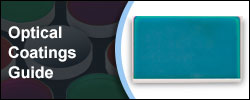
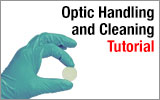
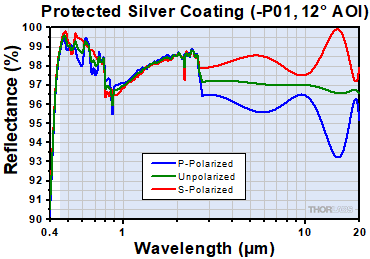
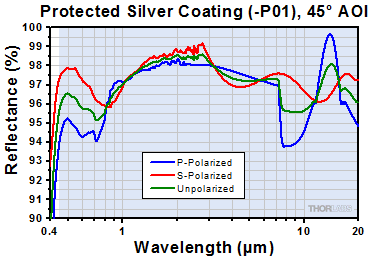
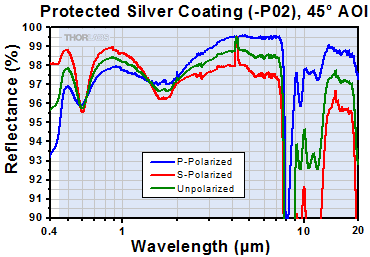

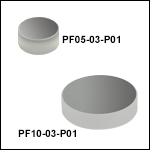
 ズーム
ズーム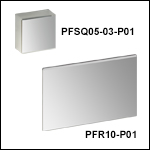
 銀ミラー
銀ミラー